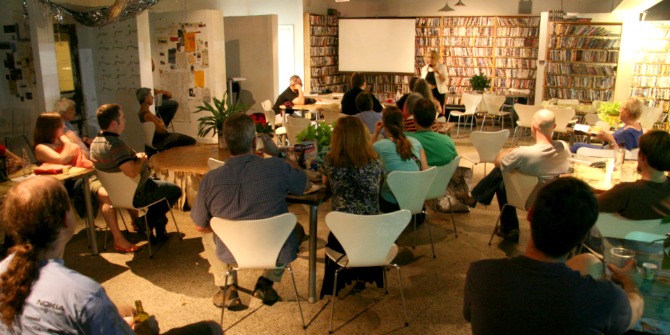 Everyone is a member of a community, and every community is continually changing. To successfully manage that change, community members need information. This book aims to give an in-depth review of all of the research methods that communities can use to solve problems, develop their resources, protect their identities, and build power. Johannes Wheeldon believes that readers seeking to understand new directions in social science research generally, or embark on their own community-based research will be well served by the mix of theory and practice, real-world examples, and student-friendly tone.
Everyone is a member of a community, and every community is continually changing. To successfully manage that change, community members need information. This book aims to give an in-depth review of all of the research methods that communities can use to solve problems, develop their resources, protect their identities, and build power. Johannes Wheeldon believes that readers seeking to understand new directions in social science research generally, or embark on their own community-based research will be well served by the mix of theory and practice, real-world examples, and student-friendly tone.
 Research Methods for Community Change: A Project Based Approach. Randy Stoecker. Second Edition. SAGE. April 2012.
Research Methods for Community Change: A Project Based Approach. Randy Stoecker. Second Edition. SAGE. April 2012.
Research Methods for Community Change begins with the premise that the quantitative turn in social science research has unnecessarily isolated many researchers from their communities. The effort to root out bias has instead sown distrust among the very participants researchers need to reach. This may have ultimately undermined the potential impact of social science research to inform those working in the communities where change is most likely to occur. This is an important and too often under discussed challenge for researchers coming of age in an era of big data. Ironically, the value of research as a prospective problem-solving tool has been sidelined by sophisticated statistical signifiers and signs and simplistic assumptions about objectivity and generalizability (pp. 6-8). Based on a usefully presented approach to participatory action research, the text explores how research can support community development, and how better university-community collaborations offer a means to build new relationships to benefit stakeholders and researchers alike (pp. 27-35).
Stoecker is uniquely qualified to consider how to address this challenge. He has been involved in a wide variety of community-based participatory research projects and evaluations across North America and Australia. He has also been an important player in the development and evaluation of university-community collaborations and service learning programs, now a fixture at many universities and colleges. Building on his previous work, this text seeks to challenge methodological approaches that tend to use data to distance research from participants, rather than to meaningfully engage with them. As everyone is a member of a community, Stoecker presents participatory research as a means for communities to identify and solve problems, protect their unique identities, and build power and purpose.
The book focuses on 4 main stages based on steps commonly associated with the project cycle. Stoeker shows how to involve community members at every stage to diagnose a community problem, prescribe an intervention, implement the prescription, and evaluate its impact. Stocker explores the role of asset mapping to identify community resources (pp. 113-121), diagnostic approaches to the research process (pp. 120-121), and the importance of informed consent and the role of Institutional Review Boards (pp. 245-250). Informed by the need for researchers to engage in reflexivity, or an awareness of how an individual’s experience shapes their understanding, the book includes sections in nearly every chapter called “Loose Gravel”. These sections offer real world examples, counter evidence, and the complications inherent in making theory fit practice and action without reflection. An additional strength is the text’s appendices, which explore topics such as Strategic Planning (pp. 237-243), Ethics and IRBs (pp. 245 – 253), Proposal Writing (pp. 255- 260), and Data Resources (pp. 261-262).
I have two concerns with the text. The first is that not enough attention is paid to the ability of charts, maps, and diagrams to convey information to readers. While some figures are very useful, I often wished for more to complement the text and to serve as easy to understand examples for readers new to these approaches. This concern extends to the limited discussion of visual means of data collection. While this is a personal peccadillo and research interest, it may have special significance for researchers attempting to reach out to communities in new ways. While there is some discussion of art, murals, participant mapping, and Photo/Voice, there are few specific examples of how these approaches can be used within the project cycle. For example, I would suggest visual approaches can be used throughout the stages Stoecker identifies. Diagrams can be used to gather data from participants, analyze possible prescriptions by researchers, and validate project plans and evaluations through iterative approaches to researcher, participant, and stakeholder mapping. Some of the discussion in the text seems to dismiss these approaches out of hand without adequate detail or explanation as to their perceived limitations.
The second issue I have is a concern with the print type. This may seem insignificant and should not be blamed on the author. A number of methods texts seem to confound the accessibility of their tone with tiny font which, while no doubt economical, impacts how the material is absorbed by students. Teaching research methods is akin to teaching a foreign language and no matter how accessible the author’s prose; presentation matters. Tiny font may just be a fact of life given the complicated and confused era of academic publishing in which authors must work. However, it ought not be ignored.
Despite these quibbles, Research Methods for Community Change is a valuable text for undergraduate and graduate students alike. Readers seeking to understand new directions in social science research generally, or embark on their own community-based research will be well served by the mix of theory and practice, real-world examples, and student-friendly tone. Stoecker offers a convincing argument that community-based case study research can allow researchers to better track cause and effect and engage communities to identify and collectively solve their own problems. His project-based approach is at once accessible and accountable to those social research is meant to benefit. He is to be praised for offering a means for the next generation to engage in the communities in which they live, rather than remain holed up in a computer lab somewhere, trying in vain to find meaningful correlations instead of simply asking more meaningful and community-informed questions.
————————————————–
Johannes Wheeldon holds degrees from Dalhousie University, the University of Durham, and Simon Fraser University. He worked at the Association of Universities and Colleges of Canada between 2002-2005 and has since worked for the American Bar Association, George Mason University, and the Center for Justice, Law, and Development. He is currently a Post Doctoral Research Fellow at the Department of Criminal Justice and Criminology at Washington State University and teaches Philosophy to inmates at the Coyote Ridge Correctional Center, the largest prison in the Pacific Northwest. His work in the prison has been recently been funded by the Open Society Institute. Read more reviews by Johannes.







